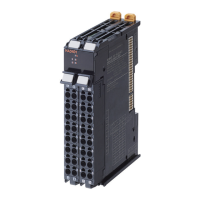Subnet Mask
Operation and management of a network can become very difficult if too many nodes are connected
on a single network. In such a case it can be helpful to configure the system so that a single network is
divided up into several subnetworks. Internally the network can be treated as a number of subnet-
works, but from the outside it acts as a single network and uses only a single network ID.
To establish subnetworks, the host ID in the IP address is divided into a subnet ID and a host ID by
using a setting called the subnet mask.
The subnet mask indicates which part of the host ID is to be used as the subnet ID. All bits in the sub-
net mask that correspond to the bits in the IP address used either as the network ID or subnet ID are
set to "1", and the remaining bits, which correspond to the bits in the IP address actually used for the
host ID, are set to
"0".
The following example shows the subnet mask for an 8-bit subnet ID used in the class-B IP address.
0
1 1 1 1 1 1 1 1 1 1 1 1 1 1 1 1 1 1 1 1 1 1 1 1 0 0 0 0 0 0 0 0 FF FF FF 00
Host IDSubnet IDNetwork ID
Host ID (16 bits)
Network ID (14 bits)
Subnet mask
Class B
Bit 31 15
1
0
Set the same subnet mask for all of the nodes on the subnetwork. The EtherNet/IP port supports
CIDR (Classless Inter-Domain Routing). The subnet mask can be set to 192.0.0.0 to 255.255.255.252.
If subnetworks are not used, set the following subnet mask values for IP address classes A to C.
Class Subnet mask
Class A 255.0.0.0
Class B 255.255.0.0
Class C 255.255.255.0
A network address is information derived from a subnet mask and used to identify each network. A
network address enables users to determine whether multiple nodes belong to the same network. A
network address is calculated by performing a logical AND operation on the IP address and subnet
mask of a node.
The following are examples of network address calculation.
In this example, the IP address of node 1 is set to 192.168.250.20, the IP address of node 2 is set to
192.168.245.30, and the subnet mask is set to 255.255.240.0. The network addresses of the two no-
des are calculated as follows.
•
Calculating network address of node 1
Item Decimal notation Binary notation
IP address 192.168.250.20 11000000.10101000.11111010.00010100
Subnet Mask 255.255.240.0 11111111.11111111.11110000.00000000
Network address 192.168.240.0 11000000.10101000.11110000.00000000
• Calculating network address of node 2
Item Decimal notation Binary notation
IP address 192.168.245.30 11000000.10101000.11111010.00010100
Subnet Mask 255.255.240.0 11111111.11111111.11110000.00000000
Network address 192.168.240.0 11000000.10101000.11110000.00000000
8 TCP/IP Functions
8-3
NX-series EtherNet/IP Unit User's Manual (W627)
8-1 Determining IP Addresses
8
8-1-1 IP Addresses
